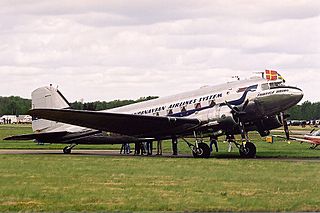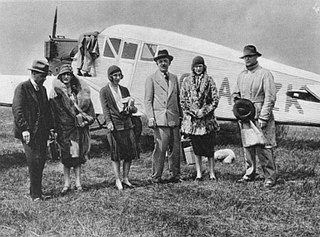
Golden Green is a village in the Medway valley near Tonbridge, Kent. It is 1 mile (1.6 km) from the larger village of Hadlow and 4 miles (6 km) from the town of Tonbridge.

The Farman F.60 Goliath was a French airliner and bomber produced by the Farman Aviation Works from 1919. It was instrumental in the creation of early airlines and commercial routes in Europe after World War I.

The 1922 Picardie mid-air collision took place on 7 April 1922 over Picardie, France, involving British and French passenger-carrying biplanes. The midair collision occurred in foggy conditions. A British aircraft flying from Croydon to Paris with only mail on board collided with a French aircraft flying three passengers from Paris to Croydon, which resulted in seven deaths.
The Compagnie des Grands Express Aériens was a pioneering French airline established 20 March 1919 and operating until merged with Compagnie des Messageries Aériennes to form Air Union on 1 January 1923.
Compagnie des messageries aériennes was a pioneering French airline which was in operation from 1919–23, when it was merged with Grands Express Aériens to form Air Union.
Air Union was a French airline established January 1, 1923, as the result of a merger between the airlines Compagnie des Messageries Aériennes and Compagnie des Grands Express Aériens. Air Union was merged with four other French airlines to become Air France on 7 October 1933.

Penshurst Airfield was an airfield in operation between 1916–36 and 1940–46. Initially a military airfield, after the First World War it was used as an alternate destination to Croydon Airport, with some civil flying taking place. The airfield closed following the crash of a Flying Flea at an air display in 1936, and was converted to a polo ground.

The October 1926 Air Union Blériot 155 crash happened on 2 October 1926 at Leigh, Kent when Blériot 155 F-AICQ caught fire in mid-air and crashed while the pilot attempted to make an emergency landing at Penshurst Airfield. Both crew members and all five passengers were killed. This was the first in-flight fire occurring on an airliner.

The August 1926 Air Union Blériot 155 crash happened on 18 August 1926 at Hurst, Kent when Blériot 155 F-AIEB of Air Union hit a barn and crashed whilst attempting to make a forced landing in bad weather. Two passengers were killed in the accident, and the pilot died a day later.

The 1947 Croydon Dakota accident occurred on 25 January 1947 when a Spencer Airways Douglas C-47A Skytrain (Dakota) failed to get airborne from Croydon Airport near London, and crashed into a parked and empty ČSA Douglas C-47 destroying both aircraft and killing 11 passengers and one crew member.

The 1934 Hillman's Airways de Havilland Dragon Rapide crash occurred on 2 October 1934 when a de Havilland DH.89A Dragon Rapide of Hillman's Airways crashed into the English Channel off Folkestone, Kent, killing all seven people on board. The aircraft was operating an international scheduled passenger flight from Abridge Aerodrome to Le Bourget Airport, Paris. The accident resulted in the first write-off of a Dragon Rapide.

The 1929 Imperial Airways Handley Page W.10 crash happened on 17 June 1929 when Handley Page W.10 G-EBMT suffered an engine failure and subsequently ditched in the English Channel off Dungeness with the loss of seven lives. The aircraft was operating an international scheduled flight from Croydon to Le Bourget Airport, Paris, France.
Marden Airfield was an airfield in Marden, Kent, United Kingdom. It was operation from 1917 to 1935. Initially a Royal Flying Corps airfield during the First World War it was used post-war as an Emergency Landing Strip, RAF Marden by the Royal Air Force. It was also known as Pagehurst Emergency Landing Ground. Later serving as a civil Emergency Landing Ground, the airfield closed in 1935. The site housed a Royal Air Force transmitter station during the Second World War.

The Meopham Air Disaster occurred on 21 July 1930 when a Junkers F.13ge flying from Le Touquet to Croydon with two crew and four passengers crashed near Meopham, Kent with the loss of all on board. The report of the inquiry into the accident was made public, the first time in the United Kingdom that an accident report was published.

The 1929 Luft Hansa Junkers G.24 crash occurred on 6 November 1929 when a Junkers G 24 of Luft Hansa crashed at Godstone, Surrey, United Kingdom while on an international scheduled flight from Croydon, Surrey, United Kingdom to Amsterdam-Schiphol Municipal Airport, Amsterdam, Netherlands. Of the eight people on board, Glen Kidston was the only survivor.

The August 1923 Air Union Farman Goliath crash occurred on 27 August 1923 when a Farman F.60 Goliath of Air Union crashed at East Malling, Kent, United Kingdom following an engine failure and reported panic amongst the passengers. One person was killed and nine were injured.

The May 1923 Air Union Farman Goliath crash occurred on 14 May 1923 when Farman F.60 Goliath F-AEBY of Air Union crashed at Monsures, Somme, France following the structural failure of a wing in flight. All six people on board were killed.

The 1923 Daimler Airway de Havilland DH.34 crash occurred on 14 September 1923 when a de Havilland DH.34 of Daimler Airway operating a scheduled domestic passenger flight from Croydon to Manchester crashed at Ivinghoe, Buckinghamshire, England, killing all five people on board.

On 29 September 1934, an Airspeed Courier of London, Scottish & Provincial Airways Ltd crashed just north of Shoreham, Kent. The aircraft was on a scheduled international passenger flight from Heston Aerodrome west of London to Le Bourget Airport, Paris. All four people on board were killed. Two people were injured by flying débris.

The 1921 SNETA Farman Goliath ditching occurred on 26 August 1921 when a Farman F.60 Goliath of Syndicat National d'Étude des Transports Aériens ditched in the North Sea off the coast of Belgium. The aircraft was operating a mail flight from Croydon Airport, United Kingdom to Brussels-Evere Airport, Belgium. The aircraft was later salvaged, repaired and returned to service.












